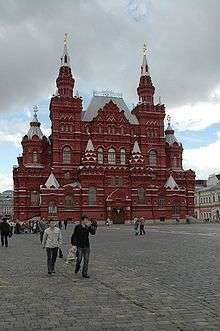Vladimir Osipovich Sherwood

Vladimir Osipovich Sherwood (Russian: Владимир Осипович Шервуд, also spelled Shervud, August 30, 1832, Istleyevo, Tambov Governorate – July 27, 1897) was a Russian painter and architect who worked in Moscow. He was an Eclectics and Russian Revival practitioner, architect of the State Historical Museum on the Red Square in Moscow. He was the son of Joseph Sherwood, an Anglo-Russian engineer whose father William Sherwood, a Catholic cotton machine engineer who had come to Russia at the invitation of Tsar Paul I on October 11, 1800.[1] Joseph died when Vladimir was five years old. His uncle John Sherwood was an influential lieutenant in the Tsar Alexander I's service. In fact John Sherwood (Ivan Shervud in Russian) was responsible for reporting the Decemberist plot in 1825, a service for which he was ennobled and given the honorific Shervud Vernyi - Sherwood the Faithful. Vladimir Osipovich became one of the most visible architects of the Alexander III version of Russian Revival, also noted for his Plevna Chapel and Nikolay Pirogov memorial in Moscow. His statue of Alexander II erected in Samara in 1889 was in 1927 replaced by one of Lenin mounted on the same plinth. His paintings include: 'Laying the foundation stone to the cotton exchange, Blackburn', 'The Preston by-election of 1862' 'Mr Healey' and 'Mrs Healey'.
He was the father of:
- Vladimir Vladimirovich Sherwood (Владимир Владимирович Шервуд, May 17, 1867 – June 18, 1930), an Art Nouveau and Neoclassical Revival architect;
- Sergei Vladimirovich Sherwood (Сергей Владимирович Шервуд, December 13, 1858 – August 29, 1899), also an architect; and
- Leonid Vladimirovich Sherwood (Леонид Владимирович Шервуд, 1871–1954), a sculptor based in Saint Petersburg, a master of socialist realism.
He was the grandfather of artist Vladimir Favorsky the son of his daughter Olga Sherwood.
References
External links
![]() Media related to Vladimir Osipovich Sherwood at Wikimedia Commons
Media related to Vladimir Osipovich Sherwood at Wikimedia Commons